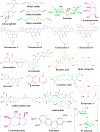Therapeutic Potential of Medicinal Plants against Dengue Infection: A Mechanistic Viewpoint
- PMID: 35874231
- PMCID: PMC9301714
- DOI: 10.1021/acsomega.2c00625
Therapeutic Potential of Medicinal Plants against Dengue Infection: A Mechanistic Viewpoint
Abstract
Dengue is a tropical disease caused by the Dengue virus (DENV), a positive-sense, single stranded RNA virus of the family Flaviviridae, which is transmitted by Aedes mosquitoes. The occurrence of dengue has grown dramatically around the globe in recent decades, and it is rapidly becoming a global burden. Furthermore, all four DENV serotypes cocirculate and create a problematic hyperendemic situation. Characteristic symptoms range from being asymptomatic, dengue fever to life-threatening complications such as hemorrhagic fever and shock. Apart from the inherent virulence of the virus strain, a dysregulated host immune response makes the condition worse. Currently, there is no highly recommended vaccine or therapeutic agent against dengue. With the advent of virus strains resistant to antiviral agents, there is a constant need for new therapies to be developed. Since time immemorial, human civilization has utilized plants in traditional medicine to treat various diseases, including infectious viral diseases. With the advancement in molecular biology, cell biology techniques, and bioinformatics, recent studies have tried to provide scientific evidence and determine the mechanism of anti-dengue activity of various plant extracts and plant-derived agents. The current Review consolidates the studies on the last 20 years of in vitro and in vivo experiments on the ethnomedicinal plants used against the dengue virus. Several active phytoconstituents like quercetin, castanospermine, α-mangostin, schisandrin-A, hirsutin have been found to be promising to inhibition of all the four DENV serotypes. However, novel therapeutics need to be reassessed in relevant cells using high-throughput techniques. Further, in vivo dose optimization for the immunomodulatory and antiviral activity should be examined on a vast sample size. Such a Review should help take the knowledge forward, validate it, and use medicinal plants in different combinations targeting multiple stages of virus infection for more effective multipronged therapy against dengue infection.
© 2022 The Authors. Published by American Chemical Society.
Conflict of interest statement
The authors declare no competing financial interest.
Figures





Similar articles
-
Innate Antiviral Immunity against Dengue Virus.Crit Rev Immunol. 2015;35(3):253-60. doi: 10.1615/critrevimmunol.2015014251. Crit Rev Immunol. 2015. PMID: 26559229 Review.
-
Dengue virus: epidemiology, biology, and disease aetiology.Can J Microbiol. 2021 Oct;67(10):687-702. doi: 10.1139/cjm-2020-0572. Epub 2021 Sep 3. Can J Microbiol. 2021. PMID: 34171205 Review.
-
Live attenuated tetravalent dengue virus host range vaccine is immunogenic in African green monkeys following a single vaccination.J Virol. 2014 Jun;88(12):6729-42. doi: 10.1128/JVI.00541-14. Epub 2014 Apr 2. J Virol. 2014. PMID: 24696467 Free PMC article.
-
Narasin, a novel antiviral compound that blocks dengue virus protein expression.Antivir Ther. 2011;16(8):1203-18. doi: 10.3851/IMP1884. Antivir Ther. 2011. PMID: 22155902
-
The Polyphenol-Rich Extract from Psiloxylon mauritianum, an Endemic Medicinal Plant from Reunion Island, Inhibits the Early Stages of Dengue and Zika Virus Infection.Int J Mol Sci. 2019 Apr 15;20(8):1860. doi: 10.3390/ijms20081860. Int J Mol Sci. 2019. PMID: 30991717 Free PMC article.
Cited by
-
Computational Advancement towards the Identification of Natural Inhibitors for Dengue Virus: A Brief Review.Comb Chem High Throughput Screen. 2024;27(17):2464-2484. doi: 10.2174/0113862073244468230921050703. Comb Chem High Throughput Screen. 2024. PMID: 37859315 Review.
-
Dengue: Update on Clinically Relevant Therapeutic Strategies and Vaccines.Curr Treat Options Infect Dis. 2023;15(2):27-52. doi: 10.1007/s40506-023-00263-w. Epub 2023 Apr 18. Curr Treat Options Infect Dis. 2023. PMID: 37124673 Free PMC article. Review.
-
Phytochemical-based nanosystems: recent advances and emerging application in antiviral photodynamic therapy.Nanomedicine (Lond). 2025 Feb;20(4):401-416. doi: 10.1080/17435889.2025.2452151. Epub 2025 Jan 23. Nanomedicine (Lond). 2025. PMID: 39848784 Review.
-
Modeling and Molecular Dynamics Studies of Flavone-DENV E-3 Protein-SWCNT Interaction at the Flavonoid Binding Sites.Viruses. 2025 Apr 4;17(4):525. doi: 10.3390/v17040525. Viruses. 2025. PMID: 40284968 Free PMC article.
-
Cordycepin exhibits both antiviral and anti-inflammatory effects against dengue virus infection.iScience. 2024 Aug 13;27(9):110711. doi: 10.1016/j.isci.2024.110711. eCollection 2024 Sep 20. iScience. 2024. PMID: 39262808 Free PMC article.
References
-
- Nonyong P.; Ekalaksananan T.; Phanthanawiboon S.; Aromseree S.; Phadungsombat J.; Nakayama E. E.; Shioda T.; Sawaswong V.; Payungporn S.; Thaewnongiew K.; Overgaard H. J.; Bangs M. J.; Alexander N.; Pientong C. Dengue Virus in Humans and Mosquitoes and Their Molecular Characteristics in Northeastern Thailand 2016–2018. PLoS One 2021, 16 (9), e025746010.1371/journal.pone.0257460. - DOI - PMC - PubMed
-
- Bhatt S.; Gething P. W.; Brady O. J.; Messina J. P.; Farlow A. W.; Moyes C. L.; Drake J. M.; Brownstein J. S.; Hoen A. G.; Sankoh O.; Myers M. F.; George D. B.; Jaenisch T.; Wint G. R. W.; Simmons C. P.; Scott T. W.; Farrar J. J.; Hay S. I. The Global Distribution and Burden of Dengue. Nature 2013, 496 (7446), 504–507. 10.1038/nature12060. - DOI - PMC - PubMed
Publication types
LinkOut - more resources
Full Text Sources

